Discover all the Mini Sculptures hidden in and around Budapest
Budapest boasts a lot of beautiful scultpures throughout the city but did you know there are over 30 mini sculptures dispersed throughout as well? Made by Hungarian-Ukrainian artist Mihály Kolodko, they are a lot of fun to discover and to learn a small bit about Budapest history as well! Below you will find a list of where all the mini sculptures are located within Budapest and the towns nearby. Have fun!
38 Places • 7 Saves • ago
Free
Veszprém
There are 3 mini scultpures located in this city
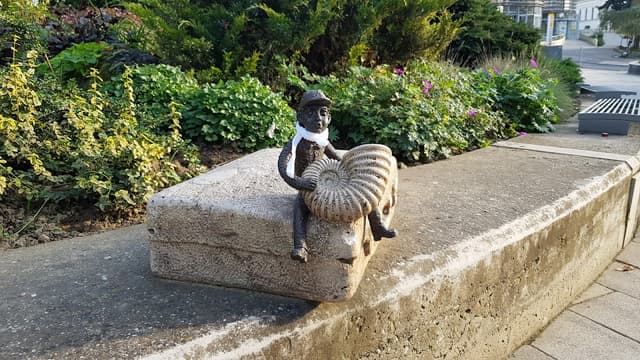
Kolodko: Ödön, az utcazenész miniszobor
@pollyf
Odon, the street musician, sits on a suitcase at the bottom of Kossuth Street opposite Hangvilla. The bohemian little creature is meant to symbolize the vibrant cultural life of Veszprém, with particular attention to the musical programs.
Add to
Details
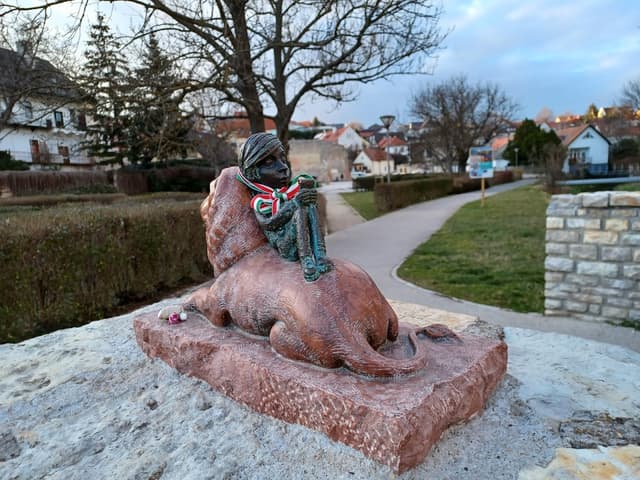
Kolodko: LeoNóra miniszobor
@pollyf
The statue of the brave little girl sitting on the lion's back symbolizes the future. The statue of the two of them is located at the end of the pedestrian bridge at the end of Kollégium Street, facing the park.
Add to
Details

Kolodko: Erne (Ernie) the guard
@pollyf
Ernő is the guardian of the Veszprém Castle, who stands on the West Pillar of the Heroes' Gate. Erno symbolizes the historical past, wearing the period uniform and helmet of the Hungarian Royal Crown Guard from the times when - between November 6 and December 6, 1944 - they guarded the Holy Right and the Holy Crown in Veszprém .
Add to
Details
Tihany
Tihany has 1 mini scultpure to discover, who is a crowd favorite!

Kolodko: Gombóc Artúr miniszobor
@pollyf
Artúr Gombóc, the chocolate eating hero of István Csukás can be found on the Pisky promenade next to Tihany Abbey.
Add to
Details
Buda
There are currently 10 mini statues spread out through Buda
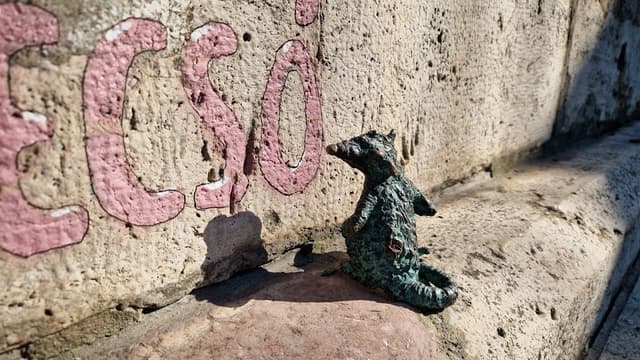
Kolodko: Lecso, the Gastro Rat
@pollyf
Lecsó, the gastro rat is a reference to the Pixar film, Ratatouille. You can find him at the Szent Gellért wharf, at the foot of the Elizabeth Bridge, opposite the Belvárosi church.
The cartooned rat is spraying the word ‘lecsó’, which is the name of an iconic Hungarian dish, vaguely similar to ratatouille.
Add to
Details

Kolodko: The Rabbit with the Checkered Ears
@pollyf
At the top of the Castle Hill Funicular, is a reference to an old Hungarian cartoon series.
The kockásfülű nyúl (Checkered ear rabbit), always chose the location of his current adventures with a telescope from some high place. At this spot, he has bird’s-eye view of the city, surveying the Danube through his telescope.
Add to
Details

Kolodko: Főkucac
@pollyf
On the Bem wharf is the mini statue of Főkucac, just a few meters from the tram stop, on the stone wall. Főkucac is the faithful assistant of the Great Ho-ho-fisherman, with whom they went fishing in the popular Hungarian cartoon. Depending on weather, sometimes she is dressed in a scarf, hat, or warm dress!
Add to
Details

Kolodko: Rubik's Cube
@pollyf
Did you know the world famous Rubik's Cube was invented in Hungary by Erno Rubik? This little cube sits in place opposite the Parliament on the railing of the stairs leading to the wharf in front of Vám utca
Add to
Details
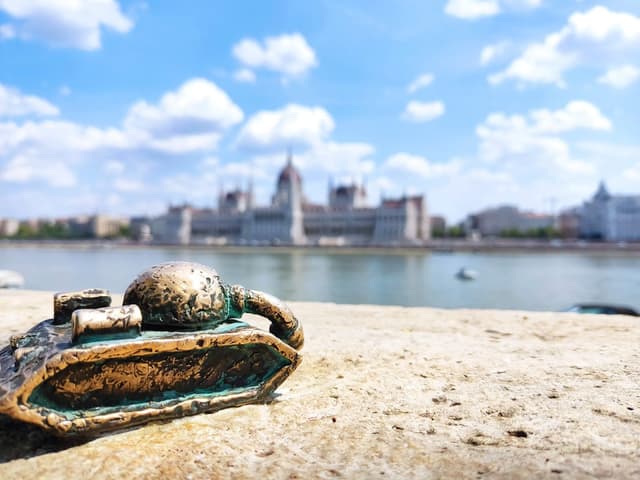
Kolodko: Mini Tank
@pollyf
Known as the sad tank, the barrel of the tank resembles a drooping elephant's trunk. It shows that the war period has ended.
Add to
Details
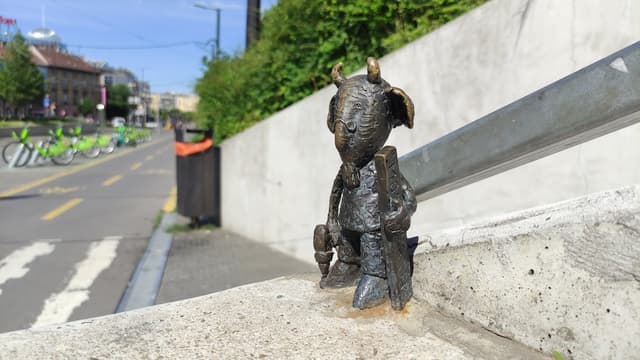
Kolodko: Elek Mekk, the Handyman
@pollyf
Located between the metro exit and Vérmező út, at the bottom of the steep stairs, is the statue of Elek Mekk, the handyman. It commemorates a a puppet series on Hungarian Television about the two left-handed goat, Master Mekk. Master Mekk holds a sign in his hand with the inscription "Moszkva tér" , referring to the fact that Széll Kálmán tér was Moskva tér between 1951 and 2011.
Add to
Details
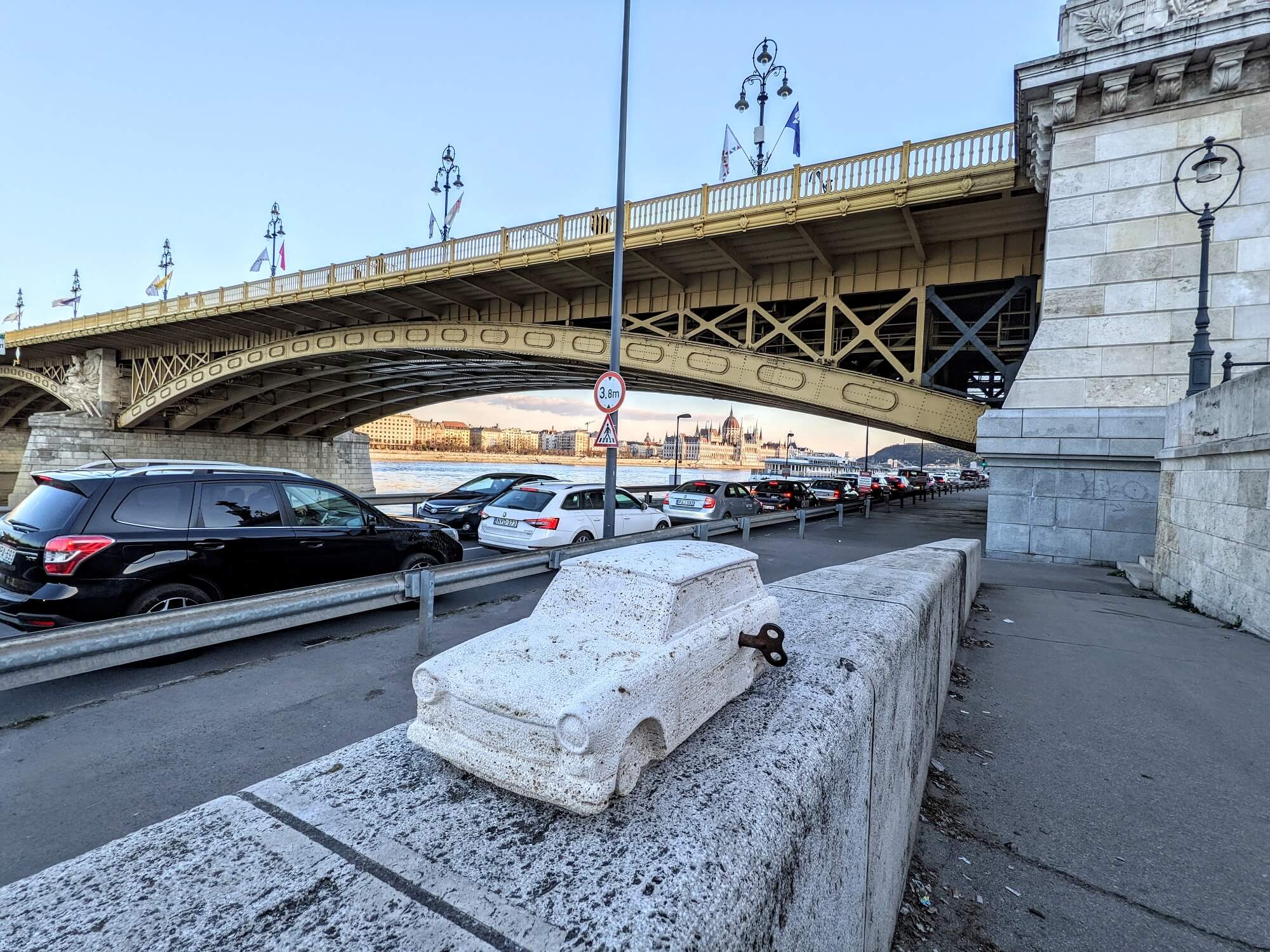
Kolodko: Felhúzható Trabant
@pollyf
Made of limestone, it represents a wind up toy, which both the car, and the toy version, were common in Hungary during Soviet times. It is located at the bridgehead on the Buda side
Add to
Details

Kolodko: In Vino Veritas
@pollyf
A tiny roman legionary is placed in the ruins of the amphitheater of Aquincum, the ancient Roman city founded on the Danube.
A jar of wine hangs from the hand of the statue, titled “In vino veritas” (“In wine, there is truth”). From the position of the legionary, he looks like he had one glass too many, and ran out of wine.
Add to
Details

Kolodko: "Egyszer volt Budán kutyavásár" miniszobrok
@pollyf
Kolodko’s “Once upon a time, there was a dog fair in Buda” is a group of mini statues featuring Hungarian breeds such as Vizsla, and Puli, but also a coin with King Matthias, because of a folk tale related to him.
According to the story of the folktale, ‘at the intercession of the righteous King Matthias’, the poor man’s dogs are bought by the nobles at the Buda Fair for good money. Hearing this, the greedy rich man turns all his wealth into money, buys dogs with it, and goes to Buda with the pack of dogs. There, however, he is chased away while being told that “once upon a time there was a dog fair in Buda, only once.” The dogs run away and the rich man’s fortune is lost.
Add to
Details
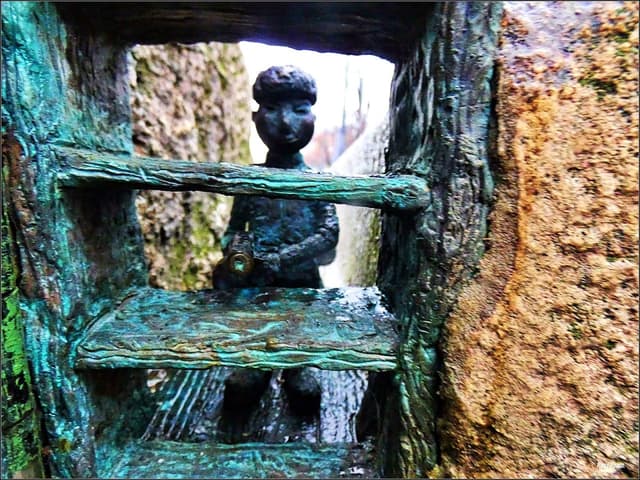
Kolodko: "Nincs kompót" miniszobor
@pollyf
A Russian soldier looks inside a (mini) pantry, where a jar of jam sits empty. Behind him, there’s a chair.
This mini sculpture is positioned in a tiny slot between the walls of the river bank in Buda, close to the Várkert Bázár.
Here, the miniaturized pantry has a functioning door. On the door, the writing “spájz” (pantry). The quote “The Russians are already in the pantry” is from the 1965 Hungarian satirical movie “The Corporal and the Others”, and it became a saying in the Hungarian language.
This is Kolodko's 2nd reaction to the 2022 war on Ukraine, his home land. The other is listed below in Pest.
Add to
Details
Pest
There are a total of 21 mini scultpures in this city!
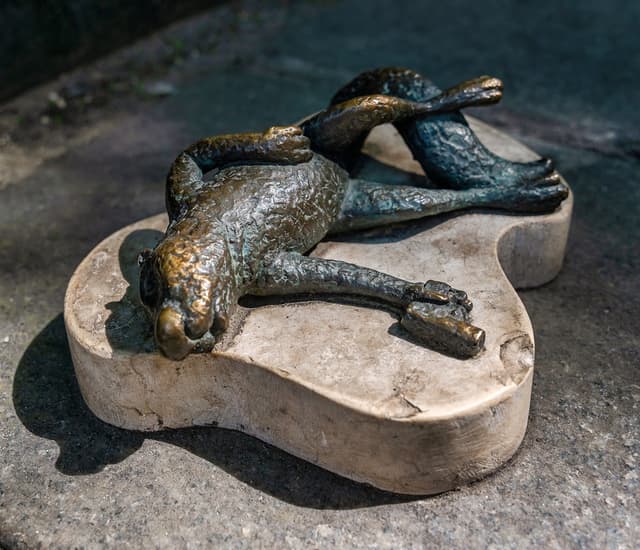
Kolodko: Dead Squirrel
@pollyf
Wandering down tree-lined Falk Miksa Street next to Columbo statue, you will discover the dead squirrel with his body outlined by chalk and his hand clutching a gun.
We don’t exactly know what happened to him but luckily enough, detective Columbo is nearby!
Add to
Details
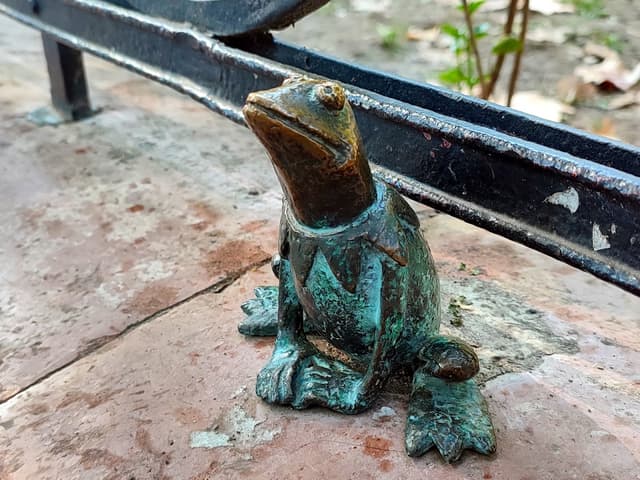
Kolodko: Frog Breki mini statue
@pollyf
Nestled next to the fence overlooking the square’s café, you’ll find this beloved Muppet.
The statue was created to recognize frog legs becoming a Hungarian delicacy in the late 19th century. Having said that, Kermit is well-loved and a super cute sculpture. If you happen to see him during the winter months, you may find that someone has dressed him in a cozy little scarf.
Add to
Details
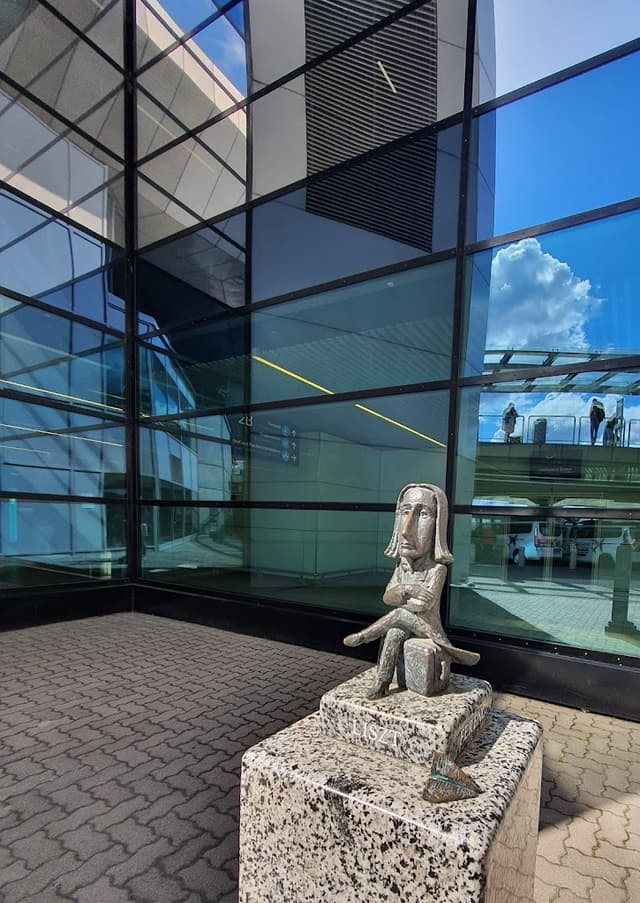
Kolodko: Liszt Ferenc miniszobor
@pollyf
My favorite mini sculpture, pays homage to this world famous Hungarian composer. It’s a fitting place for the accomplished world traveller (who can be found sitting on his suitcase and a sheet music airplane next to him), seeing as the airport was named in his honour.
Add to
Details
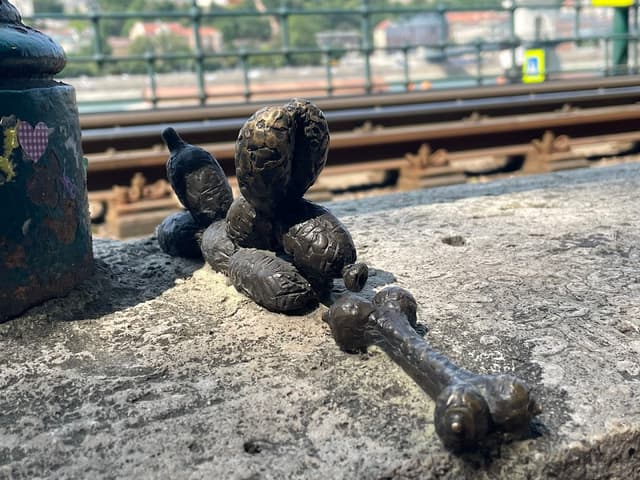
Kolodko: Libido
@pollyf
This mini statue is found near the Pest entrance of the Chain Bridge. Placed between the iron fence posts near the Corso Restaurant lies Libido, a balloon dog and homage to the scandalous artist Jeff Koons who is also known for his balloon animals and inflatable sculptures.
Add to
Details
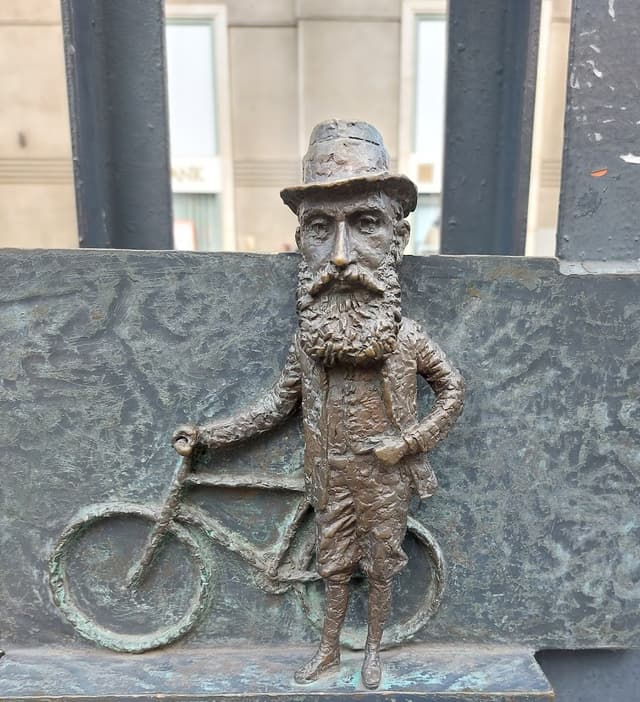
Kolodko: Tivadar Herzl
@pollyf
Tivadar Herzl was a Jewish Austrian-Hungarian journalist, writer and political activist who became known as the father of modern Zionism.
You can find Herzl with his bike (most likely inspired by a photo taken similar to this in Austria) appropriately placed near the Dohány Street Synagogue in the 7th district. Across from the sculpture, you’ll find his birth site, which is now the Jewish Museum.
Add to
Details

Kolodko: Diver
@pollyf
If you’re headed to the famous New York Café you’ll find the “key” to the café resting in the hands of a diver at the intersection of Dohány Street and Osvát Street.
Legend has it that the Hungarian author Ferenc Molnár tossed the café’s key into the river to prevent it from ever closing!
Add to
Details

Kolodko: A tizennégy karátos autó miniszobor
@pollyf
This is a tribute to the work of writer Jenő Rejtő, another Jewish resident who wrote fantastical, breakneck-paced pulp fictions stories.
The 14-Carat Roadster is one of his most famous tales and can be found right in front of the Pesti Magyar Színház.
Add to
Details

Kolodko: Urinal
@pollyf
A tribute to Marcel Duchamp’s controversial 1917 sculpture, Fountain (itself a signed porcelain urinal).
This one is a little to find and is tucked away on the wall surrounding Vajdahunyad Castle moat.
Add to
Details

Kolodko: Holdjáró miniszobor
@pollyf
Hungarian born Ferenc Pavlics came up with the lightweight but resilient wheels needed to traverse the Moon on the Lunar Rover. He was presented the NASA Award for his achievements.
Appropriately, this one can be found on Hold (Moon in English) street on its own moon-shaped bollard.
Add to
Details
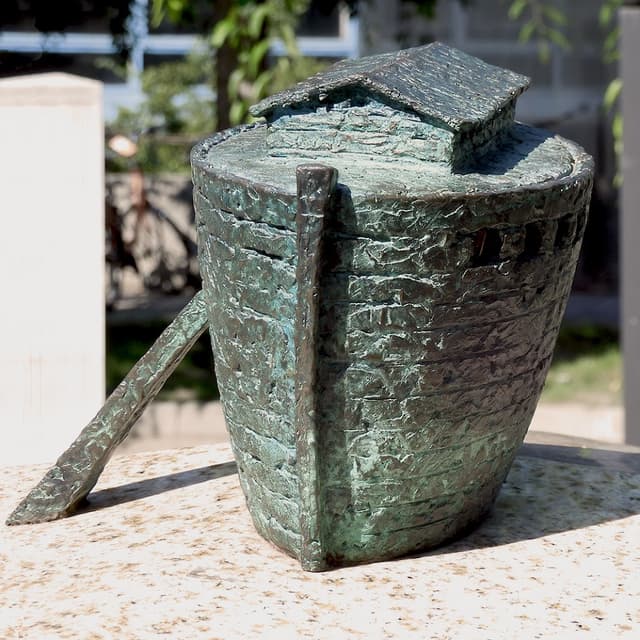
Kolodko: Noé bárkája miniszobor
@pollyf
If you look inside Noah's Ark, you’ll be rewarded with the rainbow that symbolised the end of the flood, recreated in its beautiful multicoloured windows! If you come after sunset, you can flash your phone light to see it inside.
Add to
Details
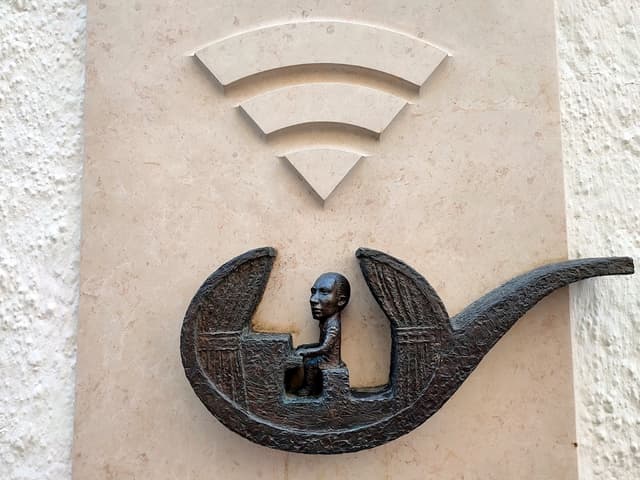
Kolodko: Seress Rezső miniszobor
@pollyf
Rezső Seress is a Hungarian songwriter that was very popular between the wars. This tribute was placed near the Kispipa restaurant-bar, where he worked as a musician.
Add to
Details

Kolodko: Hanna Szenes
@pollyf
This wonderful tribute is for the female Jewish war hero, Hanna Szenes. Szenes volunteered to parachute into Yugoslavia during World War II in order to assist anti-Nazi forces.
This tribute to an incredibly brave woman is also part of the #wonderwomenbudapest initiative which aims to rebalance the gender divide in the city’s sculptures.
Add to
Details

Kolodko: Axe
@pollyf
Liberty Square has long been an ideological battleground, with controversial monuments from every political era of Hungary’s history and Kolodko included his of an Ushanka (Russian Hat) mini-statue, criticising a perceived continuing Russian influence in Hungarian politics.
One far-right politician didn’t take too kindly to it, destroying the statue with an axe and throwing it into the Danube. The sculptor responded with this sardonic comeback, both mocking and memorialising the violence of his aggressor.
Add to
Details
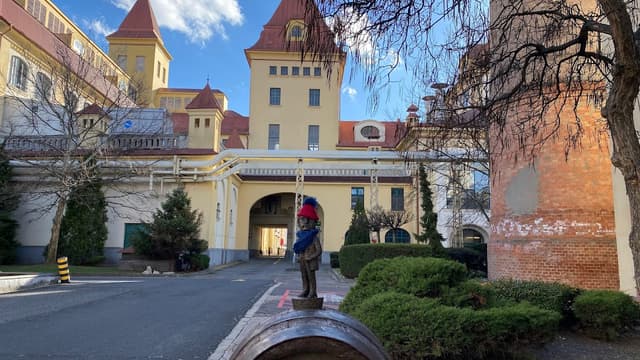
Kolodko: Dreher Antal miniszobor
@pollyf
On the gate of Dreher Brewery, you can see a pair of dray horses pulling barrels of the good stuff, but venture inside and you’ll see the man himself: Antal Dreher Sr.
Add to
Details

Kolodko: Mr. Bean mackója miniszobor
@pollyf
Known as Brexit, this mini sculpture is mounted on the wall of the former British Embassy at Harmincad utca. This bear will be instantly recognizable to most as Mr. Bean’s beloved Teddy. In divisive times, it may help bring a little comfort to a fractured union.
Add to
Details
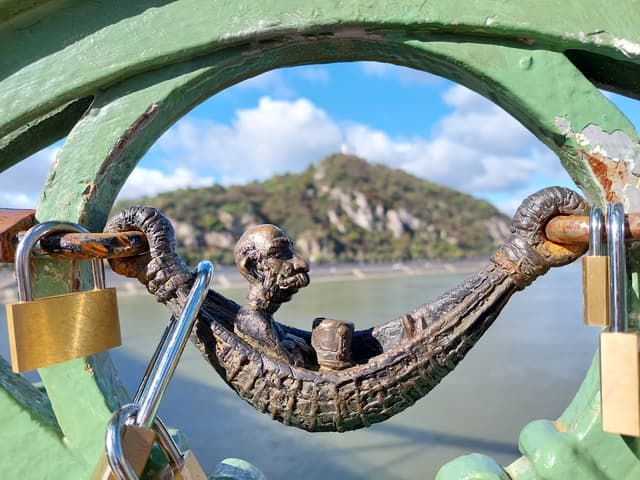
Kolodko: King Franz Joseph
@pollyf
The Austrian Emperor (and former King of Hungary) Franz Joseph mini sculpture can be found on Liberty Bridge. The choice of location was significant, as the bridge used to bear the Habsburg ruler’s name.
The hammock refers to those who took over the bridge while it was closed to road traffic a few years back. Hammocks hung high from the bridge’s cables as people took the chance to relax and chill in one of Budapest’s most iconic spots.
Add to
Details
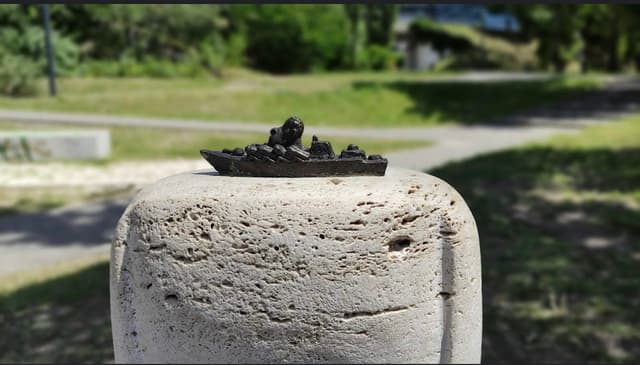
Kolodko: "Message" (Russian warship) mini-sculpture
@pollyf
This mini statue in Budapest represents Putin on a warship. This statue is actually big, as the miniature lays on a giant middle finger of stone, which can be interpreted in more ways than one.
The mini statue is installed fittingly on the pier named Moscow, like one of the 2 warships that attacked Snake Island on February 24th, 2022, the first day of the Russian invasion of Ukraine.
While Kolodko resides in Budapest, he is originally from Ukraine and has many friends & family back in his native land.
Add to
Details
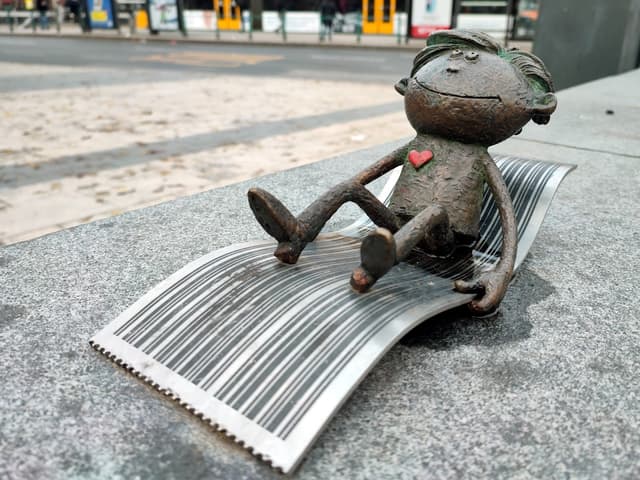
Kolodko: Skála Kópé miniszobor
@pollyf
Kolodko unlocks the memories of thousands of Hungarians with a tribute to Kópé, the cartoon mascot of the main Hungarian retail chain in the Eighties.
Skálá Stores was advertised on national TV by a cheeky boy named Kópé, from “Coop”, singing catchy jingles.
Now a little Kópé cheers passersby in busy Nyugati Square, where 1984’s Skálá Metró building hosts more modern stores. His heart pops outside, remembering how Skálá stores were meant to steal people’s hearts.
Add to
Details

Kolodko: Among Us
@pollyf
Kolodko placed a mini statue of 2 boots on a skateboard, on a side of the new Ethnography Museum, in 1956’s Square. According to the artist, this is the only statue that he planned to install on a specific day: October 23 is, in fact, it’s the national holiday commemorating the revolution of 1956 against the Soviet regime.
During the revolution, the people of Budapest tore down the massive statue of Stalin which was standing right in the square by the City Park. Stalin’s boots, the only part of the statue that “resisted” the revolution, remained a symbol of the communist regime in Hungary, and this place was called “Boots Square” for years.
There are two boots, one for the past (Stalin), and one for the current oppression. The mini boots have the bones sticking out: on one side it’s a symbol for the need to cut the system that led to the current war, on the other, a reference to a popular video game “Among Us”. The boots are on a skateboard, because the new museum, which opened in May 2022, is shaped like a skate ramp.
Add to
Details
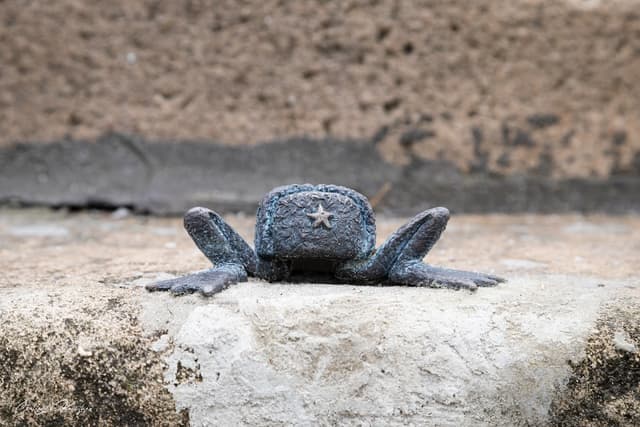
Kolodko: Usánka visszatér miniszobor
@pollyf
The mini statue of a Russian hat with a frog’s legs represents the return of an earlier Kolodko’s work. In 2019 the Ushanka (the typical winter hat) was thrown into the Danube by a right-wing member of the Parliament who removed it with an axe.
The ushanka is now back from the water, right next to the House of Parliament’s visitor center.
Add to
Details
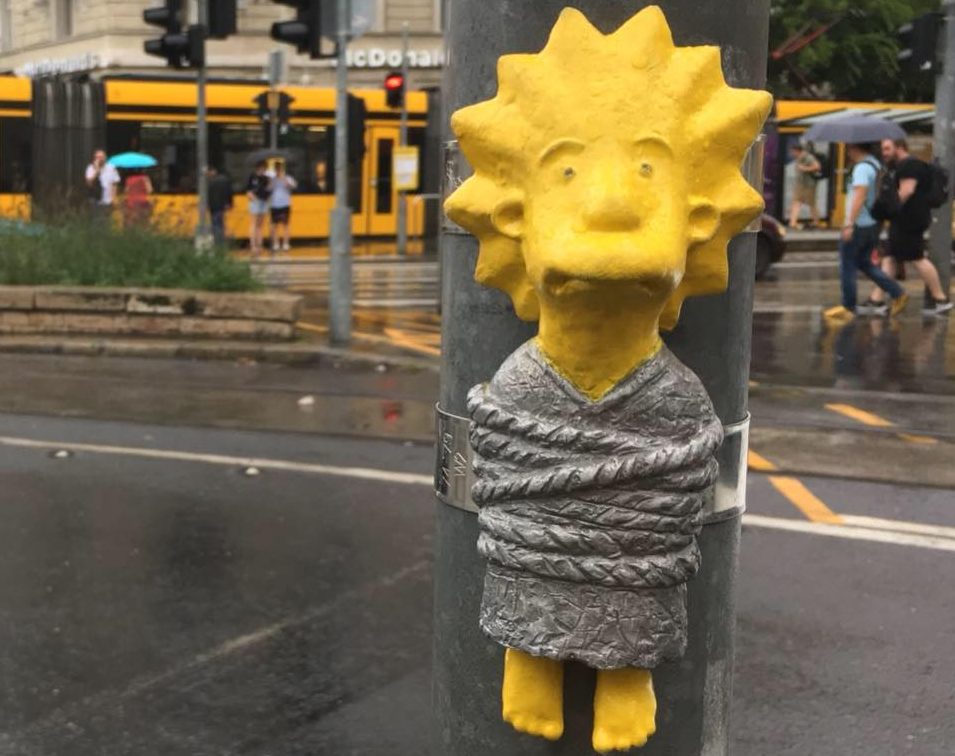
Kolodko: Lisa Simpson
@pollyf
Add to
Details
Vác
There are 3 mini scultpures located in this city
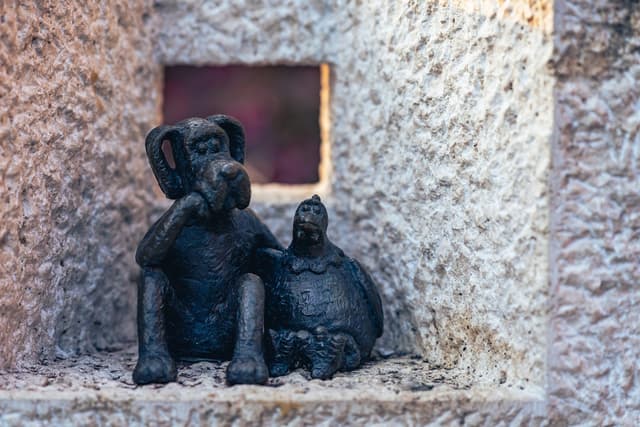
Kolodko: Anyám tyúkja miniszobor
@pollyf
This little scultpure is a nod to the parents of poet Sándor Petőfi who lived at Báthori utca 15 in Vác in 1847-48. Petőfi was here in February 1848 when he composed a poem involving the family dog Morzsa and mother hen.
The characters are sitting on their own plinth by the main station building.
Add to
Details

Kolodko: Csúzlis miniszobor
@pollyf
A mini-statue referring to cartoonist Ferenc Sajdik's collection can be found in front of the Pannónia House (which inside is where the collection is housed!)
The man aims its slingshot at the center of the main square, and according to others, at the Church of the Whites on the far side of the square.
Add to
Details
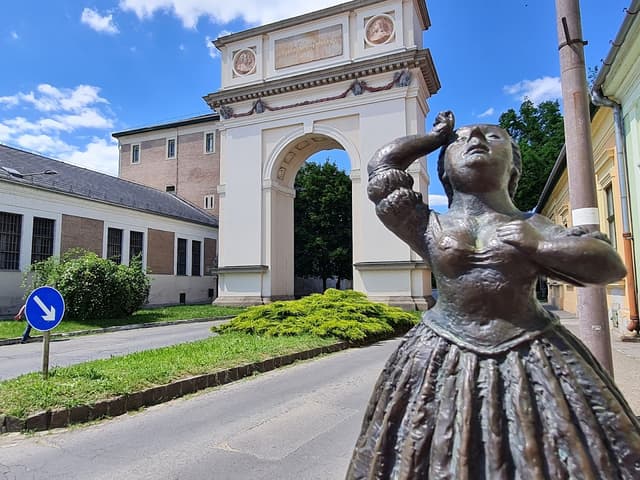
Kolodko: Mária Terézia eksztázisa miniszobor
@pollyf
At the base of the Arc de Triomphe, is a mini sculpture of Mária Terézia. Legend has it is that she came to visit the town of Vac, who built a 15-meter-high triumphal arch in a record speed of 2 weeks.
When Maria arrived, she was afraid to go under it at the risk that it would collapse. This sculpture captures that anxious moment, since the statue really looks as if she would faint at the sight of the Stone Gate!
Add to
Details
* * *
CURATED BY
Hello I am Polly! I grew up in Vancouver BC and love this city dearly. With my guides, you can rest assured that every recommendation I offer comes from personal experience and a genuine appreciation for delicious food.
Shop my guides and find me on Instagram (@deeee.lish) or tiktok (@deeeelish) to start planning your next trip!
PERSONALIZED TRAVEl SERVICES
Connect
with
a
local
expert
to
help
plan
your
ideal
trip
Send A Tip
Support Polly F’s work.
Select your tip amount
$5
$10
$20
$50
Or type in other amount
Read more about places in this guide

Discover all the Mini Sculptures hidden in and around Budapest
Budapest boasts a lot of beautiful scultpures throughout the city but did you know there are over 30 mini sculptures dispersed throughout as well? Made by Hungarian-Ukrainian artist Mihály Kolodko, they are a lot of fun to discover and to learn a small bit about Budapest history as well! Below you will find a list of where all the mini sculptures are located within Budapest and the towns nearby. Have fun!
38 Places • 7 Saves • ago
Free

Veszprém
There are 3 mini scultpures located in this city

Kolodko: Ödön, az utcazenész miniszobor
@pollyf
Odon, the street musician, sits on a suitcase at the bottom of Kossuth Street opposite Hangvilla. The bohemian little creature is meant to symbolize the vibrant cultural life of Veszprém, with particular attention to the musical programs.
Add to
Details

Kolodko: LeoNóra miniszobor
@pollyf
The statue of the brave little girl sitting on the lion's back symbolizes the future. The statue of the two of them is located at the end of the pedestrian bridge at the end of Kollégium Street, facing the park.
Add to
Details

Kolodko: Erne (Ernie) the guard
@pollyf
Ernő is the guardian of the Veszprém Castle, who stands on the West Pillar of the Heroes' Gate. Erno symbolizes the historical past, wearing the period uniform and helmet of the Hungarian Royal Crown Guard from the times when - between November 6 and December 6, 1944 - they guarded the Holy Right and the Holy Crown in Veszprém .
Add to
Details
Tihany
Tihany has 1 mini scultpure to discover, who is a crowd favorite!

Kolodko: Gombóc Artúr miniszobor
@pollyf
Artúr Gombóc, the chocolate eating hero of István Csukás can be found on the Pisky promenade next to Tihany Abbey.
Add to
Details
Buda
There are currently 10 mini statues spread out through Buda

Kolodko: Lecso, the Gastro Rat
@pollyf
Lecsó, the gastro rat is a reference to the Pixar film, Ratatouille. You can find him at the Szent Gellért wharf, at the foot of the Elizabeth Bridge, opposite the Belvárosi church.
The cartooned rat is spraying the word ‘lecsó’, which is the name of an iconic Hungarian dish, vaguely similar to ratatouille.
Add to
Details

Kolodko: The Rabbit with the Checkered Ears
@pollyf
At the top of the Castle Hill Funicular, is a reference to an old Hungarian cartoon series.
The kockásfülű nyúl (Checkered ear rabbit), always chose the location of his current adventures with a telescope from some high place. At this spot, he has bird’s-eye view of the city, surveying the Danube through his telescope.
Add to
Details

Kolodko: Főkucac
@pollyf
On the Bem wharf is the mini statue of Főkucac, just a few meters from the tram stop, on the stone wall. Főkucac is the faithful assistant of the Great Ho-ho-fisherman, with whom they went fishing in the popular Hungarian cartoon. Depending on weather, sometimes she is dressed in a scarf, hat, or warm dress!
Add to
Details

Kolodko: Rubik's Cube
@pollyf
Did you know the world famous Rubik's Cube was invented in Hungary by Erno Rubik? This little cube sits in place opposite the Parliament on the railing of the stairs leading to the wharf in front of Vám utca
Add to
Details

Kolodko: Mini Tank
@pollyf
Known as the sad tank, the barrel of the tank resembles a drooping elephant's trunk. It shows that the war period has ended.
Add to
Details

Kolodko: Elek Mekk, the Handyman
@pollyf
Located between the metro exit and Vérmező út, at the bottom of the steep stairs, is the statue of Elek Mekk, the handyman. It commemorates a a puppet series on Hungarian Television about the two left-handed goat, Master Mekk. Master Mekk holds a sign in his hand with the inscription "Moszkva tér" , referring to the fact that Széll Kálmán tér was Moskva tér between 1951 and 2011.
Add to
Details

Kolodko: Felhúzható Trabant
@pollyf
Made of limestone, it represents a wind up toy, which both the car, and the toy version, were common in Hungary during Soviet times. It is located at the bridgehead on the Buda side
Add to
Details

Kolodko: In Vino Veritas
@pollyf
A tiny roman legionary is placed in the ruins of the amphitheater of Aquincum, the ancient Roman city founded on the Danube.
A jar of wine hangs from the hand of the statue, titled “In vino veritas” (“In wine, there is truth”). From the position of the legionary, he looks like he had one glass too many, and ran out of wine.
Add to
Details

Kolodko: "Egyszer volt Budán kutyavásár" miniszobrok
@pollyf
Kolodko’s “Once upon a time, there was a dog fair in Buda” is a group of mini statues featuring Hungarian breeds such as Vizsla, and Puli, but also a coin with King Matthias, because of a folk tale related to him.
According to the story of the folktale, ‘at the intercession of the righteous King Matthias’, the poor man’s dogs are bought by the nobles at the Buda Fair for good money. Hearing this, the greedy rich man turns all his wealth into money, buys dogs with it, and goes to Buda with the pack of dogs. There, however, he is chased away while being told that “once upon a time there was a dog fair in Buda, only once.” The dogs run away and the rich man’s fortune is lost.
Add to
Details

Kolodko: "Nincs kompót" miniszobor
@pollyf
A Russian soldier looks inside a (mini) pantry, where a jar of jam sits empty. Behind him, there’s a chair.
This mini sculpture is positioned in a tiny slot between the walls of the river bank in Buda, close to the Várkert Bázár.
Here, the miniaturized pantry has a functioning door. On the door, the writing “spájz” (pantry). The quote “The Russians are already in the pantry” is from the 1965 Hungarian satirical movie “The Corporal and the Others”, and it became a saying in the Hungarian language.
This is Kolodko's 2nd reaction to the 2022 war on Ukraine, his home land. The other is listed below in Pest.
Add to
Details
Pest
There are a total of 21 mini scultpures in this city!

Kolodko: Dead Squirrel
@pollyf
Wandering down tree-lined Falk Miksa Street next to Columbo statue, you will discover the dead squirrel with his body outlined by chalk and his hand clutching a gun.
We don’t exactly know what happened to him but luckily enough, detective Columbo is nearby!
Add to
Details

Kolodko: Frog Breki mini statue
@pollyf
Nestled next to the fence overlooking the square’s café, you’ll find this beloved Muppet.
The statue was created to recognize frog legs becoming a Hungarian delicacy in the late 19th century. Having said that, Kermit is well-loved and a super cute sculpture. If you happen to see him during the winter months, you may find that someone has dressed him in a cozy little scarf.
Add to
Details

Kolodko: Liszt Ferenc miniszobor
@pollyf
My favorite mini sculpture, pays homage to this world famous Hungarian composer. It’s a fitting place for the accomplished world traveller (who can be found sitting on his suitcase and a sheet music airplane next to him), seeing as the airport was named in his honour.
Add to
Details

Kolodko: Libido
@pollyf
This mini statue is found near the Pest entrance of the Chain Bridge. Placed between the iron fence posts near the Corso Restaurant lies Libido, a balloon dog and homage to the scandalous artist Jeff Koons who is also known for his balloon animals and inflatable sculptures.
Add to
Details

Kolodko: Tivadar Herzl
@pollyf
Tivadar Herzl was a Jewish Austrian-Hungarian journalist, writer and political activist who became known as the father of modern Zionism.
You can find Herzl with his bike (most likely inspired by a photo taken similar to this in Austria) appropriately placed near the Dohány Street Synagogue in the 7th district. Across from the sculpture, you’ll find his birth site, which is now the Jewish Museum.
Add to
Details

Kolodko: Diver
@pollyf
If you’re headed to the famous New York Café you’ll find the “key” to the café resting in the hands of a diver at the intersection of Dohány Street and Osvát Street.
Legend has it that the Hungarian author Ferenc Molnár tossed the café’s key into the river to prevent it from ever closing!
Add to
Details

Kolodko: A tizennégy karátos autó miniszobor
@pollyf
This is a tribute to the work of writer Jenő Rejtő, another Jewish resident who wrote fantastical, breakneck-paced pulp fictions stories.
The 14-Carat Roadster is one of his most famous tales and can be found right in front of the Pesti Magyar Színház.
Add to
Details

Kolodko: Urinal
@pollyf
A tribute to Marcel Duchamp’s controversial 1917 sculpture, Fountain (itself a signed porcelain urinal).
This one is a little to find and is tucked away on the wall surrounding Vajdahunyad Castle moat.
Add to
Details

Kolodko: Holdjáró miniszobor
@pollyf
Hungarian born Ferenc Pavlics came up with the lightweight but resilient wheels needed to traverse the Moon on the Lunar Rover. He was presented the NASA Award for his achievements.
Appropriately, this one can be found on Hold (Moon in English) street on its own moon-shaped bollard.
Add to
Details

Kolodko: Noé bárkája miniszobor
@pollyf
If you look inside Noah's Ark, you’ll be rewarded with the rainbow that symbolised the end of the flood, recreated in its beautiful multicoloured windows! If you come after sunset, you can flash your phone light to see it inside.
Add to
Details

Kolodko: Seress Rezső miniszobor
@pollyf
Rezső Seress is a Hungarian songwriter that was very popular between the wars. This tribute was placed near the Kispipa restaurant-bar, where he worked as a musician.
Add to
Details

Kolodko: Hanna Szenes
@pollyf
This wonderful tribute is for the female Jewish war hero, Hanna Szenes. Szenes volunteered to parachute into Yugoslavia during World War II in order to assist anti-Nazi forces.
This tribute to an incredibly brave woman is also part of the #wonderwomenbudapest initiative which aims to rebalance the gender divide in the city’s sculptures.
Add to
Details

Kolodko: Axe
@pollyf
Liberty Square has long been an ideological battleground, with controversial monuments from every political era of Hungary’s history and Kolodko included his of an Ushanka (Russian Hat) mini-statue, criticising a perceived continuing Russian influence in Hungarian politics.
One far-right politician didn’t take too kindly to it, destroying the statue with an axe and throwing it into the Danube. The sculptor responded with this sardonic comeback, both mocking and memorialising the violence of his aggressor.
Add to
Details

Kolodko: Dreher Antal miniszobor
@pollyf
On the gate of Dreher Brewery, you can see a pair of dray horses pulling barrels of the good stuff, but venture inside and you’ll see the man himself: Antal Dreher Sr.
Add to
Details

Kolodko: Mr. Bean mackója miniszobor
@pollyf
Known as Brexit, this mini sculpture is mounted on the wall of the former British Embassy at Harmincad utca. This bear will be instantly recognizable to most as Mr. Bean’s beloved Teddy. In divisive times, it may help bring a little comfort to a fractured union.
Add to
Details

Kolodko: King Franz Joseph
@pollyf
The Austrian Emperor (and former King of Hungary) Franz Joseph mini sculpture can be found on Liberty Bridge. The choice of location was significant, as the bridge used to bear the Habsburg ruler’s name.
The hammock refers to those who took over the bridge while it was closed to road traffic a few years back. Hammocks hung high from the bridge’s cables as people took the chance to relax and chill in one of Budapest’s most iconic spots.
Add to
Details

Kolodko: "Message" (Russian warship) mini-sculpture
@pollyf
This mini statue in Budapest represents Putin on a warship. This statue is actually big, as the miniature lays on a giant middle finger of stone, which can be interpreted in more ways than one.
The mini statue is installed fittingly on the pier named Moscow, like one of the 2 warships that attacked Snake Island on February 24th, 2022, the first day of the Russian invasion of Ukraine.
While Kolodko resides in Budapest, he is originally from Ukraine and has many friends & family back in his native land.
Add to
Details

Kolodko: Skála Kópé miniszobor
@pollyf
Kolodko unlocks the memories of thousands of Hungarians with a tribute to Kópé, the cartoon mascot of the main Hungarian retail chain in the Eighties.
Skálá Stores was advertised on national TV by a cheeky boy named Kópé, from “Coop”, singing catchy jingles.
Now a little Kópé cheers passersby in busy Nyugati Square, where 1984’s Skálá Metró building hosts more modern stores. His heart pops outside, remembering how Skálá stores were meant to steal people’s hearts.
Add to
Details

Kolodko: Among Us
@pollyf
Kolodko placed a mini statue of 2 boots on a skateboard, on a side of the new Ethnography Museum, in 1956’s Square. According to the artist, this is the only statue that he planned to install on a specific day: October 23 is, in fact, it’s the national holiday commemorating the revolution of 1956 against the Soviet regime.
During the revolution, the people of Budapest tore down the massive statue of Stalin which was standing right in the square by the City Park. Stalin’s boots, the only part of the statue that “resisted” the revolution, remained a symbol of the communist regime in Hungary, and this place was called “Boots Square” for years.
There are two boots, one for the past (Stalin), and one for the current oppression. The mini boots have the bones sticking out: on one side it’s a symbol for the need to cut the system that led to the current war, on the other, a reference to a popular video game “Among Us”. The boots are on a skateboard, because the new museum, which opened in May 2022, is shaped like a skate ramp.
Add to
Details

Kolodko: Usánka visszatér miniszobor
@pollyf
The mini statue of a Russian hat with a frog’s legs represents the return of an earlier Kolodko’s work. In 2019 the Ushanka (the typical winter hat) was thrown into the Danube by a right-wing member of the Parliament who removed it with an axe.
The ushanka is now back from the water, right next to the House of Parliament’s visitor center.
Add to
Details

Kolodko: Lisa Simpson
@pollyf
Add to
Details
Vác
There are 3 mini scultpures located in this city

Kolodko: Anyám tyúkja miniszobor
@pollyf
This little scultpure is a nod to the parents of poet Sándor Petőfi who lived at Báthori utca 15 in Vác in 1847-48. Petőfi was here in February 1848 when he composed a poem involving the family dog Morzsa and mother hen.
The characters are sitting on their own plinth by the main station building.
Add to
Details

Kolodko: Csúzlis miniszobor
@pollyf
A mini-statue referring to cartoonist Ferenc Sajdik's collection can be found in front of the Pannónia House (which inside is where the collection is housed!)
The man aims its slingshot at the center of the main square, and according to others, at the Church of the Whites on the far side of the square.
Add to
Details

Kolodko: Mária Terézia eksztázisa miniszobor
@pollyf
At the base of the Arc de Triomphe, is a mini sculpture of Mária Terézia. Legend has it is that she came to visit the town of Vac, who built a 15-meter-high triumphal arch in a record speed of 2 weeks.
When Maria arrived, she was afraid to go under it at the risk that it would collapse. This sculpture captures that anxious moment, since the statue really looks as if she would faint at the sight of the Stone Gate!
Add to
Details
* * *
CURATED BY
Hello I am Polly! I grew up in Vancouver BC and love this city dearly. With my guides, you can rest assured that every recommendation I offer comes from personal experience and a genuine appreciation for delicious food.
Shop my guides and find me on Instagram (@deeee.lish) or tiktok (@deeeelish) to start planning your next trip!
PERSONALIZED TRAVEl SERVICES
Connect
with
a
local
expert
to
help
plan
your
ideal
trip
Send A Tip
Support Polly F’s work.
Select your tip amount
$5
$10
$20
$50
Or type in other amount
Read more about places in this guide